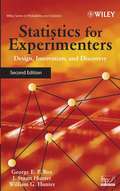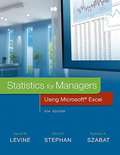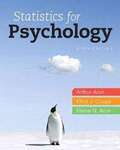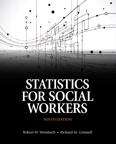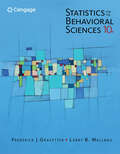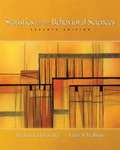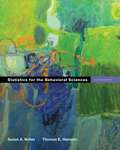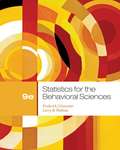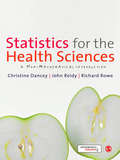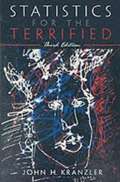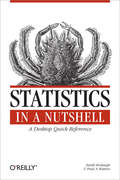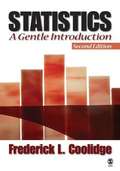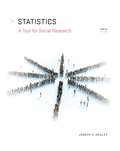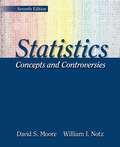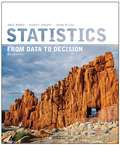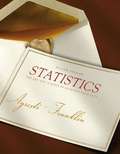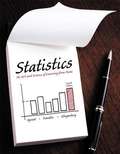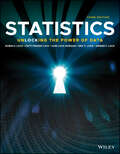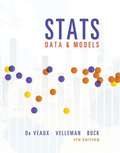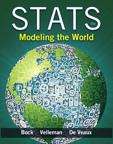- Table View
- List View
Statistics class 12 - Tamil Nadu Board
by Training State Council of Educational ResearchKey Factors about the book: Learning objectives are brief statements that describe what students will be expected to learn by the end of school year, course, unit, lesson or class period. Additional information about the concept. Amazing facts, Rhetorical questions to lead students to statistic inquiry. Assess students' critical thinking and their understanding. To enhance digital skills among students.
Statistics for Business and Economics (Special Edition)
by David R. Anderson Dennis J. Sweeney Thomas A. Williams Jeffrey D. CammStatistics for Business and Economics by Jeffrey D. Camm, Thomas A. Williams, Dennis J. Sweeney, and David R. Anderson.
Statistics for Experimenters: Design, Innovation, and Discovery (Second Edition)
by George E.P. Box J. Stuart Hunter William G. HunterThe book intends to make available to experimenters scientific and statistical tools that can greatly catalyze innovation, problem solving, and discovery and illustrate how these tools may be used by and with subject matter specialists as their investigations proceed.
Statistics for Managers Using Microsoft Excel
by David Levine David Stephan Kathryn Szabat<p>For undergraduate business statistics courses. Analyzing the Data Applicable to Business. This text is the gold standard for learning how to use Microsoft Excel® in business statistics, helping students gain the understanding they need to be successful in their careers. The authors present statistics in the context of specific business fields; full chapters on business analytics further prepare students for success in their professions. Current data throughout the text lets students practice analyzing the types of data they will see in their professions. The friendly writing style include tips throughout to encourage learning. <p>The book also integrates PHStat, an add-in that bolsters the statistical functions of Excel.</p>
Statistics for Psychology (MyStatLab Series)
by Elaine Aron Arthur Aron Elliot CoupsStatistics for Psychology, 6th edition places definitional formulas center stage to emphasize the logic behind statistics and discourage rote memorization. Each procedure is explained in a direct, concise language and both verbally and numerically. <p><p> MyStatLab is an integral part of the Statistics course. MyStatLab gives students practice with hundreds of homework problems. Every problem includes tools to help students understand and solve each problem - and grades all of the problems for instructors. MyStatLab also includes tests, quizzes, eText, a Gradebook, a customizable study plan, and much more.
Statistics for Social Workers (Ninth Edition)
by Robert W. Weinbach Richard M. GrinnellThis book intends to be a reference for social work practitioners who, increasingly, are involved in agency-based research projects, and who must critically evaluate the reports of research findings in order to remain effective evidence-based practitioners.
Statistics for the Behavioral Sciences
by Larry B. Wallnau Frederick J GravetterStatistics is one of the most practical and essential courses that you will take, and a primary goal of this popular text is to make the task of learning statistics as simple as possible. Straightforward instruction, built-in learning aids, and real-world examples have made STATISTICS FOR THE BEHAVIORAL SCIENCES, 10th Edition the text selected most often by instructors for their students in the behavioral and social sciences. The authors provide a conceptual context that makes it easier to learn formulas and procedures, explaining why procedures were developed and when they should be used. This text will also instill the basic principles of objectivity and logic that are essential for science and valuable in everyday life, making it a useful reference long after you complete the course.
Statistics for the Behavioral Sciences
by Frederick J. Gravetter Larry B. WallnauMaster statistics with STATISTICS FOR THE BEHAVIORAL SCIENCES! With straightforward instruction, built-in learning aids, and real world examples, this psychology text provides you with the tools you need to succeed. You will have numerous opportunities to practice statistical techniques through learning checks, examples, demonstrations, and problems. Exam preparation is made easy with a student companion website that provides tutorials, crossword puzzles, flashcards, learning objectives, and more!
Statistics for the Behavioral Sciences (2nd Edition)
by Susan A. Nolan Thomas E. HeinzenIn this new edition, author tries to connect students to statistical concepts efficiently and refocuses on the core concepts of the course and introduces each topic with a vivid example.
Statistics for the Behavioral Sciences (9th Edition)
by Larry B. Wallnau Frederick J GravetterThe author illustrates the importance of statistics in the study of behavioral science and how it provides researchers with objective and systematic methods for describing and interpreting their research results.
Statistics for the Health Sciences: A Non-Mathematical Introduction
by Christine Dancey Richard Rowe John ReidyStatistics for the Health Sciences is a highly readable and accessible textbook on understanding statistics for the health sciences, both conceptually and via the SPSS programme. The authors give clear explanations of the concepts underlying statistical analyses and descriptions of how these analyses are applied in health science research without complex maths formulae. The textbook takes students from the basics of research design, hypothesis testing and descriptive statistical techniques through to more advanced inferential statistical tests that health science students are likely to encounter. The strengths and weaknesses of different techniques are critically appraised throughout, and the authors emphasise how they may be used both in research and to inform best practice care in health settings. Exercises and tips throughout the book allow students to practice using SPSS. The companion website provides further practical experience of conducting statistical analyses. Features include: * multiple choice questions for both student and lecturer use * full Powerpoint slides for lecturers * practical exercises using SPSS * additional practical exercises using SAS and R This is an essential textbook for students studying beginner and intermediate level statistics across the health sciences.
Statistics for the Terrified
by John H. KranzlerStatistics for the Terrified, 3/E, is a user-friendly introduction to elementary statistics, intended primarily for the reluctant, math anxious/avoidant person. Written in a personal and informal style, with healthy doses of humor and encouragement, the aim of the book is to help readers make the leap from apprehension to comprehension of elementary statistics. The book presents state-of-the-art, empirically supported self-help strategies (based on the cognitive behavioral techniques of rational emotive therapy) that help readers manage their math anxiety so they can relax and build confidence while still learning statistics. For those who need to learn statistics to further their career.
Statistics in a Nutshell
by Sarah Boslaugh Paul Andrew WattersNeed to learn statistics as part of your job, or want some help passing a statistics course? Statistics in a Nutshell is a clear and concise introduction and reference that's perfect for anyone with no previous background in the subject. This book gives you a solid understanding of statistics without being too simple, yet without the numbing complexity of most college texts. You get a firm grasp of the fundamentals and a hands-on understanding of how to apply them before moving on to the more advanced material that follows. Each chapter presents you with easy-to-follow descriptions illustrated by graphics, formulas, and plenty of solved examples. Before you know it, you'll learn to apply statistical reasoning and statistical techniques, from basic concepts of probability and hypothesis testing to multivariate analysis. Organized into four distinct sections, Statistics in a Nutshell offers you:Introductory material: Different ways to think about statistics Basic concepts of measurement and probability theoryData management for statistical analysis Research design and experimental design How to critique statistics presented by others Basic inferential statistics: Basic concepts of inferential statistics The concept of correlation, when it is and is not an appropriate measure of association Dichotomous and categorical data The distinction between parametric and nonparametric statistics Advanced inferential techniques: The General Linear Model Analysis of Variance (ANOVA) and MANOVA Multiple linear regression Specialized techniques: Business and quality improvement statistics Medical and public health statistics Educational and psychological statistics Unlike many introductory books on the subject, Statistics in a Nutshell doesn't omit important material in an effort to dumb it down. And this book is far more practical than most college texts, which tend to over-emphasize calculation without teaching you when and how to apply different statistical tests. With Statistics in a Nutshell, you learn how to perform most common statistical analyses, and understand statistical techniques presented in research articles. If you need to know how to use a wide range of statistical techniques without getting in over your head, this is the book you want.
Statistics: A Gentle Introduction
by Frederick L. CoolidgeDoing statistics for the first time? Don't panic says Professor Fred Coolidge. In Statistics: A Gentle Introduction, Second Edition, he shows how statistics needn't be difficult or dull. Dr. Coolidge likens the role of a statistician to that of a curious detective, an honest attorney, and a good storyteller. He minimizes the use of formulas, but provides a step-by-step approach to their solution, and includes a glossary of key terms, symbols, and definitions at the end of each chapter. Every chapter also includes a short story about historical and contemporary statisticians who figured prominently in the evolution of the discipline of statistics. This second edition includes specific suggestions as to the detection of baloney, that is, fraudulent claims and questionable studies.
Statistics: A Tool For Social Research (Tenth Edition)
by Joseph F. HealeyPacked with everyday examples of statistics in the real world, STATISTICS: A TOOL FOR SOCIAL RESEARCH, 10e, provides a reader-friendly introduction to the fundamental concepts of statistics and their practical application to a wide variety of contemporary social issues. Using myriad examples of statistics from daily life, the text demonstrates that statistics are not just abstract mathematical constructs but have practical value in government, education, business, media, politics, sports, and much more. STATISTICS helps you understand the importance of statistical fundamentals in research without requiring advanced mathematical knowledge. It supports effective learning for both math-averse beginners as well as more advanced students in diverse social science disciplines. Focusing on the application of computational research in favor of the computations themselves, the text fully integrates with the most current version of IBM's SPSS software and labels end-of-chapter SPSS problems by the discipline from which they are drawn. The author breaks down even the most complex material to help you master key concepts and develop the skills you need to succeed as a professional in a social science field-or simply to become a "statistically literate" consumer of social research.
Statistics: Concepts And Controversies
by David S. Moore William I. NotzStatistics: Concepts and Controversies (SCC) is a book on statistics as a liberal discipline, that is, as part of the general education of "non-mathematical" students.
Statistics: From Data to Decision
by Ann E. Watkins George W. Cobb Richard L. ScheafferStatistics, 2nd Edition teaches statistics with a modern, data-analytic approach that uses graphing calculators and statistical software. It allows more emphasis to be put on statistical concepts and data analysis rather than following recipes for calculations. This gives readers a more realistic understanding of both the theoretical and practical applications of statistics, giving them the ability to master the subject.
Statistics: Informed Decisions Using Data Fifth Edition
by Michael SullivanFor courses in introductory statistics. Statistics: Informed Decisions Using Data, Fifth Edition, gives students the tools to see a bigger picture and make informed choices. As a current introductory statistics instructor, Mike Sullivan III presents a text that is filled with ideas and strategies that work in today's classroom. His practical emphasis resonates with students and helps them see that statistics is connected, not only to individual concepts, but also with the world at large.
Statistics: Principles and Methods
by Richard Johnson Gouri BhattacharyyaStatistics: Principles and Methods, 8th Edition provides students and business professionals with a comprehensive introduction to statistics concepts, terminology, and methods with a wide array of practical applications. Real-world data provides an easily relatable frame of reference, while numerous examples reinforce key ideas and demonstrate critical concepts to help ease student comprehension. Designed for those seeking a highly practical introduction to statistical measurement, reasoning, and analysis, this book requires no specific mathematical background and leaves derivations behind in favor of logic, reasoning, and modern statistics software. <P><P>Concepts are introduced first in a real-life setting to illustrate immediate relevancy, and are subsequently expanded to relate underlying mechanisms, limitations, and further applications. An emphasis on the relationship between validity and assumptions underscores the importance of critical thinking and the use of appropriate models while instilling thoughtful habits that lead to accuracy in interpretation. Going beyond the typical introductory text to keep the focus on application, this book gives students a deeper understanding of statistics as it is used every day across disciplines and industries.
Statistics: The Art and Science of Learning from Data (2nd Edition)
by Alan Agresti Christine FranklinAlan Agresti and Chris Franklin have merged their research and classroom experience to develop this successful introductory statistics text. Statistics: The Art and Science of Learning from Data, Second Edition helps readers become statistically literate by encouraging them to ask and answer interesting statistical questions. It takes the ideas that have turned statistics into a central science in modern life and makes them accessible and engaging to readers without compromising necessary rigor.
Statistics: The Art and Science of Learning from Data (Fourth Edition)
by Alan Agresti Christine Franklin Bernhard KlingenbergThe fourth edition of this textbook aims at improving the student and instructor user experience to learn statistics from the traditional formula-driven mathematical statistics course to a concept-driven approach. This concept-driven approach places more emphasis on why statistics is important in the real world and places less emphasis on mathematical probability. The book aims to help students make the conceptual approach more interesting and more readily accessible.
Statistics: Unlocking the Power of Data
by Patti Frazer Lock Robin H. Lock Kari Lock Morgan Eric F. Lock Dennis F. LockStatistics: Unlocking the Power of Data, 3rd Edition is designed for an introductory statistics course focusing on data analysis with real-world applications. Students use simulation methods to effectively collect, analyze, and interpret data to draw conclusions. Randomization and bootstrap interval methods introduce the fundamentals of statistical inference, bringing concepts to life through authentically relevant examples. More traditional methods like t-tests, chi-square tests, etc. are introduced after students have developed a strong intuitive understanding of inference through randomization methods. While any popular statistical software package may be used, the authors have created StatKey to perform simulations using data sets and examples from the text. A variety of videos, activities, and a modular chapter on probability are adaptable to many classroom formats and approaches. <P><P><i>Advisory: Bookshare has learned that this book offers only partial accessibility. We have kept it in the collection because it is useful for some of our members. Benetech is actively working on projects to improve accessibility issues such as these.</i>
Stats in Your World
by Richard D. De Veaux Paul F. Velleman David E. Bock Thomas J. Mariano“This text presents Statistics as a key tool for thinking about the world. By leading with real-world examples, clear graphics, and practical data analysis, we get students "doing Statistics" quickly and "thinking statistically" right from the start. The questions that motivate our hundreds of examples and exercises highlight the wide applicability of Statistics, teach the methods and procedures of proper data analysis, and--most importantly--emphasize thinking about what the results mean. We modeled the first edition on Stats: Modeling the World, the highly successful AP® Statistics book, and have been thrilled by feedback from all sides. Teachers are delighted that students can and do learn from reading the text, and their students say (to their amazement) that they even find the book enjoyable. The book's engaging style, support for underlying math skills, and scaffolded materials that enable success for all students tie all the skills and concepts to the world we live in. In this course and with this textbook, you can say goodbye to that oft-uttered math class question, "When does anyone ever use this stuff?"!” – from the book.
Stats: Data and Models, 4th edition
by Richard D. De Veaux Paul F. Velleman David E. BockWith a conversational, humorous, and informal writing style, this new edition engages students from the first page. The authors focus on statistical thinking throughout the text and rely on technology for calculations. As a result, students can focus on developing their conceptual understanding. Innovative Think/Show/Tell examples give students a problem-solving framework and, more importantly, a way to think through any statistics problem and present their results.
Stats: Modeling The World (Fourth Edition)
by Richard D. De Veaux Paul F. Velleman David E. Bock Paul D. VellemanClear, accessible, and teachable, Stats: Modeling the World leads with practical data analysis and graphics to engage students and get them thinking statistically from the start. Through updated, relevant examples and data--and the authors' signature Think, Show, and Tell problem-solving method--students learn what we can find in data, why we find it interesting, and how to report it to others. The new Fourth Edition is even more engaging than previous editions, builds on the innovative features that have made the first three editions so popular, and includes revisions designed to make it even easier for students to put the concepts of statistics together in a coherent whole.

